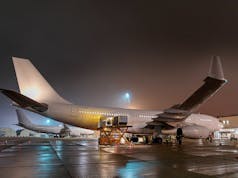NATO’s Alliance Ground Surveillance Force (NAGSF) has clocked hundreds of flying hours gathering vital intelligence along the eastern border of the Alliance since the onset of 2022 and Russia’s invasion of Ukraine.
The remotely piloted RQ-4D aircraft have been capturing a vast array of Intelligence, Surveillance and Reconnaissance (ISR) data, crucial for the defence and deterrence activities of NATO’s 31 member countries.
Brigadier General Christoph Pliet, Deputy Chief of Staff Operations at Allied Air Command in Ramstein, highlighted the aircraft’s importance, stating, “The NATO RQ-4D is a key contributor to the situational awareness of the Alliance.”
He explained that the data collected by the NAGSF team of multinational experts at the AGS Main Operating Base at Sigonella is processed and then shared with all NATO member nations. This data informs decisions on military operations aimed at protecting NATO allies.
The NAGSF RQ-4D drones operate at high altitudes above 50,000 feet, well above civilian air traffic, and fly over both NATO allied territories and international waters.
Brigadier General Andrew Clark, NAGSF Commander, emphasized the cooperative efforts among NATO members: “NAGSF is a prime example of member nations successfully working together to preserve the integrity of Allied territory.”
He confirmed that the NAGSF would continue to exploit its “unique and critical capability to deter our adversaries and defend the Alliance.”
NAGSF serves as a significant asset in maintaining continuous and comprehensive situational awareness. Its key role is not just data collection but also in collating, exploiting, and distributing intelligence that helps NATO to adapt and respond at tactical, operational, and strategic levels.













Yet the Germans STILL complain about the program.
To police a grain corridor you need continuous oversight and realtime communication to allies. Sorted!